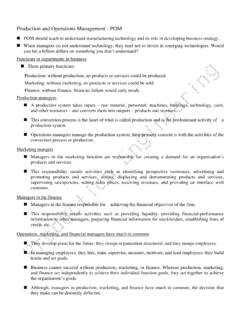Transcription of Latin Pronunciation Guide - txclassics.org
1 Latin Pronunciation Guide Latin may be a dead language but it is very much alive when you read it and speak it. It lives in the echo of the words that were spoken long ago by the great men of Ancient Rome. Inscriptional evidence as well as texts from ancient grammarians tell us how the Romans pronounced Latin during the classical period. This simple Guide will provide you with the You may ask, Why should I bother to learn the difference between long and short vowels? Why should I bother learning macrons (the long marks)? Here is the best reply I know: Learning macrons is a piece of cake if you just learn proper Pronunciation which is important.
2 Macrons simply indicate vowel quantity, just like spelling in English, and that can mean a lot; after all, a cape is a cape, and not a cap (that silent -e); a sheep is a sheep, and not a ship; and a sheet is a sheet and not a .. well, you get the idea: Easy to learn and important to know. 2 A simplified Pronunciation Guide is as follows: VOWELS LONG VOWEL SHORT VOWEL as in father: m ter, gr ti s, cl mat, v ll a as in Dinah: pater, quattuor, salv , taberna as in they: salv te, tr s, c na, hodi e as in pet: bene, septem, vehementer as in machine: qu nque, f lius, scr bit i as in pin: tibi, mihi, n vis, ita, videt as in clover: n n, oct , le , m ns, n men o as in orb, off: oct , novem, hortus, hodi as in rude: nus, ndecim, t , sal tat u as in put.
3 Ut, unda, cul na, uxor, ululat DIPHTHONGS (combinations of two vowel sounds collapsed together into a single syllable) ae as ai in aisle: puellae, quaes , saepe au as ou in house: laudat, aut, paul sper ei as reign: deinde oe as oi in oil: coepit ui as in Latin u + i, spoken as a single syllable like Spanish muy or English gooey, pronounced quickly as a single syllable, and occuring only in the following words: cuius, huius, cui, hui, huic. Otherwise the two letters are spoken separately. CONSONANTS Latin consonants had essentially the same sounds as the English consonants with the following exceptions: 1 For a more detailed account of restored classical Pronunciation , see Vox Latina by W.
4 Sidney Allen, Cambridge University Press; Reprint edition (August 17, 1989) ISBN: 0521379369. 2 Richard A. LaFleur, Franklin Professor of Classics, University of Georgia at Athens. The majority of this Pronunciation Guide is based upon information in Wheelock s Latin , edited by Richard A. LaFleur. Many of the Latin examples have been changed to words familiar to beginning Latin students (using the Cambridge Latin Course). Ginny Lindzey, Porter Middle School, January 2004. bs and bt were pronounced ps and pt, as in urbs, obtul , obstat, obstin tus c was always hard, as in cul na, canis, tac , circum, c vis g was always hard, as in v gint , ag , gustat, gerit i (as a consonant) usually had the sound of y as in English yes: i nua, i dex, iubet, iam, iacet qu is always followed by u as in English: quoque, coquus, quis, quaerit r was trilled.
5 The Roman littera can na (sound of a snarling dog): r det, perterritus, forum, r s s was voiceless as in English see: salv , senex, subit , servus, susurr vit t was always hard as in tac , tabl num, tibi, turba, tuba v had the sound of w as in v lla, via, val , v gint , venit, videt, vibrat x had the sound of ks as in senex, exit, mend x, exspectat, vexat, d xit ch had the sound of ckh as in English block head: pulcher, charta, architectus ph had the sound of ph as in English up hill: amphora, amphithe trum th had the sound of th as in English hot house: the trum, thermae gn had the sound of ngn as in English wing nut: magnus, benignus, ign vus Nota bene: The Romans pronounced double consonants as separate consonants.
6 For instance, the tt in admittent sounded like the two t s in admit ten. Compare redit (he goes back) and reddit (he gives back), calidus (hot) and callidus (clever), m les (soldier) and m lle (thousand). SYLLABIFICATION 1. Two vowels or a vowel and a diphthong are separated: puella, pu-el-la; f liae, f -li-ae; hodi , ho-di- ; the trum, the- -trum 2. A single consonant between two vowels goes with the second vowel: am cus, a-m -cus; f lius, f -li-us; gr ti s, gr -ti- s; agricola, a-gri-co-la 3. When two or more consonants stand between two vowels, generally only the last consonant goes with the second vowel: ancilla, an-cil-la; salv , sal-v ; quattuor, quat-tu-or.
7 However, a stop (p, b, t, d, c, g) + a liquid (l, r) count as a single consonant: patrem, pa-trem; agricola, a-gri-co-la. Also, qu, ch, ph, th count as a single consonant: amphithe trum, am-phi-the- -trum. SYLLABLE QUANTITY A syllable is heavy (long) by nature if it contains a long vowel or diphthong; a syllable is heavy by position if it contains a short vowel followed by two or more consonants or by x, which is a double consonant (=ks). Otherwise the syllable is considered light (short). Syllables heavy by nature (underlined): ho-di- , gr -ti- s, sal-v , quae-s Syllables heavy by position (underlined): ser-vat, por-tat, pu-el-la ACCENT You place the accents on Latin words following these simple rules: 1.
8 The accent is never on the last (ultimate) syllable. 2. In a word of two syllables, the accent always falls on the first syllable: ser vus, mi hi, oc t . 3. In a word of three or more syllables a. the accent falls on the next to last (penultimate) syllable, if that syllable is heavy: pu-el la, sal-v te, ta-bl num, v -gin t b. otherwise the accent falls on the syllable before that (the antepenultimate syllable): gr ti- s, quat tu-or, n de-cim, tr -cl ni-um And remember, your most important goal is consistency, especially in vowel length. Sloppy Pronunciation indicates that the words were never learned as they should be voiced.
9







